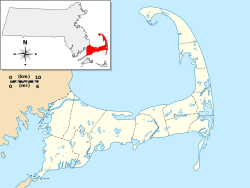United States historic place
| Eastham Center Historic District | |
| U.S. National Register of Historic Places | |
| U.S. Historic district | |
 Eastham Windmill, built in 1680 Eastham Windmill, built in 1680 | |
   | |
| Location | Eastham, Massachusetts |
|---|---|
| Coordinates | 41°49′40″N 69°58′24″W / 41.82778°N 69.97333°W / 41.82778; -69.97333 |
| Area | 31 acres (13 ha) |
| Architect | Cummings, Charles K.; et al. |
| Architectural style | Georgian, Late Victorian |
| NRHP reference No. | 99000560 |
| Added to NRHP | May 12, 1999 |
The Eastham Center Historic District is a historic district encompassing the main village center of Eastham, Massachusetts. This village center grew around the railroad station, which was built in 1870. The arrival of the railroad resulted in a shift of economic and civic activity from the old town center, a short way to the north. Prominent buildings in the district include the Town Hall (2500 State Highway), a Colonial Revival structure built in 1912, the Library (190 Samoset Road), built in 1897, and the Universalist Chapel (220 Samoset Road), built 1889. The main focal point of the district is Windmill Park, location of the Eastham Windmill, built c. 1680 and moved to Eastham in the 1790s; it is the oldest windmill on Cape Cod. The district was added to the National Register of Historic Places in 1999.
See also
References
- ^ "National Register Information System". National Register of Historic Places. National Park Service. April 15, 2008.
- "NRHP nomination for Eastham Center Historic District". Commonwealth of Massachusetts. Retrieved May 10, 2014.
| U.S. National Register of Historic Places in Massachusetts | |||||||||||||||||
|---|---|---|---|---|---|---|---|---|---|---|---|---|---|---|---|---|---|
| Topics |  | ||||||||||||||||
| Lists by county | |||||||||||||||||
| Lists by city |
| ||||||||||||||||
| Other lists | |||||||||||||||||
This article is about a historic property or district in Barnstable County, Massachusetts, that is listed on the National Register of Historic Places, is a stub. You can help Misplaced Pages by expanding it. |